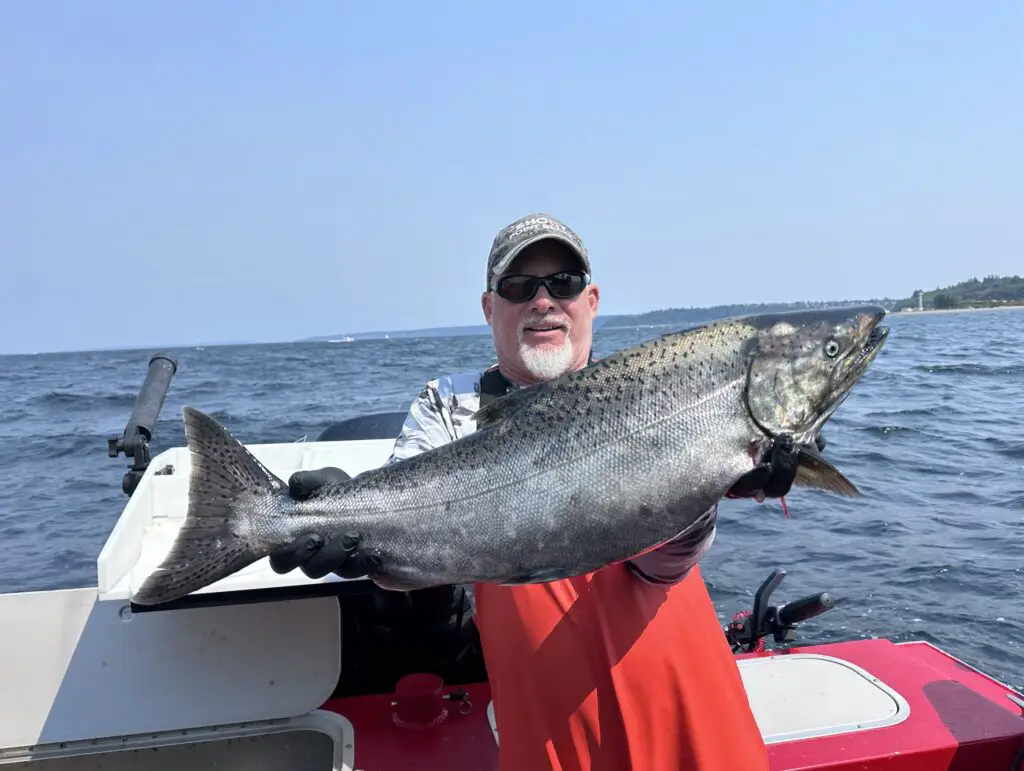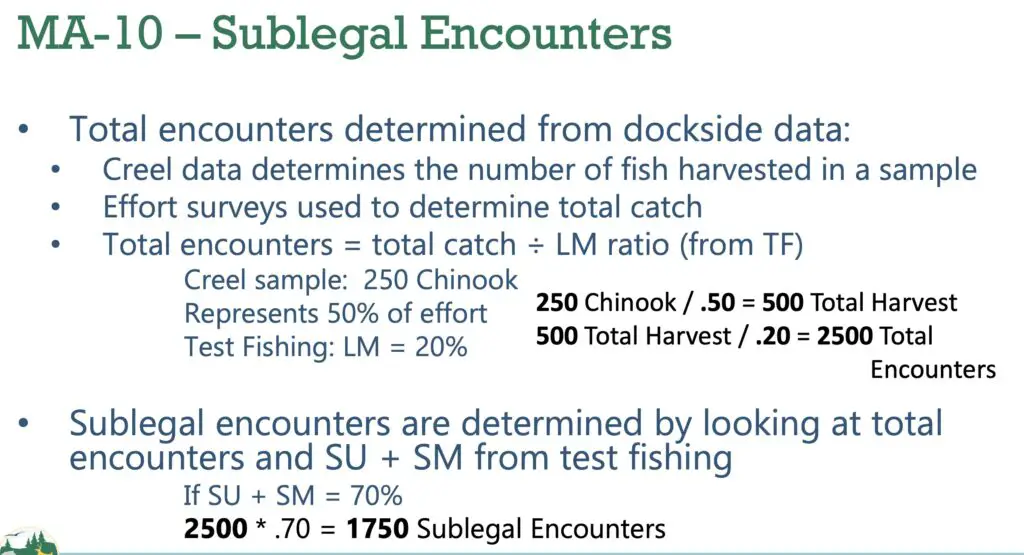
The summer salmon season in 2023 was one of the absolute best in quite some time!
The abundance of coho and chinook results in many wonderful fish-catching adventures throughout the Puget Sound, Strait, and Ocean.
However, many anglers will best remember 2023 for the two very confusing, confounding, and anger-inducing closures that occurred in Marine Area 10 and Marine Area 11.
This blog article attempts to explain the Marine Area 10 closure in much greater detail than how most of us have previously understood it.
Let’s start with a helpful recap of what ocurred:
The season for hatchery chinook retention began on Jul 13th, 2023 for Marine Area 10. The following note was sent on Aug 3rd, 2023 from WDFW to those on the emergency rules/in-season update mailing list:
The current estimate of Chinook sublegal encounters for the summer fishery is 9,471 of 7,748 total sublegal encounters (122%) agreed to in this year’s List of Agreed Fisheries (LOAF). Therefore, WDFW will close the fishery to Chinook retention.
WDFW Email on Aug 3rd
Many anglers were frustrated as the full run of chinook was just starting to show up a few days prior and now the season was being shut down.
And this is on top of Marine Area 11 having shut down in early July.
How does WDFW determine sublegal encounters?
The question many will have is of course, how does WDFW figure out that the recreational fleet has encountered 9,471 sublegal chinook at this point in the season?
The easier number to explain is 7,748 sublegal encounters is the agreed-upon limit set as part of North of Falcon.
We could find many problems with this 7,748 sublegal encounter quota, but that’s probably a different blog article. For now, I’m focussed on explaining the estimated 9,471.
There are three important numbers that determine the estimate of sublegal encounters:
- Creel data from dockside creel surveys determines how many legal chinook have been harvested
- Efforts surveys count the total number of boats on the water
- Test fishing ratio’s determine how #1 and #2 translate to sublegal encounters.
Here’s the math:
Let’s say the recreational fleet was creel sampled as retaining 10 legal chinook on a given day in the season.
And let’s also suppose that 100 boats were creel checked, but 200 boats were on the water.
This means that the estimated retention of legal chinook that day was 10 divided by 100/200 (50%) translating to a total of 20 legal chinook.
Now if the test fishing data shows a ratio of 1 legal chinook for every 5 chinook caught (encountered), then the estimate of total chinook encountered is 20 divided by .2 (20%), which would equal 100 chinook total encountered.
Still with me?
Okay, now if the sublegal encounter rate from test fishing was 50%, then that’s multiplied by the 100 chinook encounters to get a total of 50 sublegal encounters.
Simple, right?
Here’s an example from a WDFW slide explaining the math if that helps you further.

Now, you might be thinking: “How can we possibly trust such a small test fishing sample size to determine such a critical season management number?”
This is a good thought, but more on this in a minute.
We were all pleasantly surprised by the following email from WDFW on Aug 10th about a re-opening,
The Marine Area 10 summer Chinook fishery was closed on Aug. 4 after estimates of sublegal Chinook under the 22-inch minimum size limit encounter had reached 122% (9,471 of 7,748) of the limit agreed to in this year’s List of Agreed Fisheries. Additional test fishing during the first week of August before the closure indicated legal-sized marked Chinook increased in the area, which dropped the estimate of sublegal encounters to 75% (5,836 of 7,748). This provided room for additional days of Chinook retention in Marine Area 10.
WDFW Email on Aug 10th
Wait, what?!?
How did the estimate of the running total count of sublegal encounters go down? How is this number being calculated?!?
I’m fortunate to be part of a group of involved anglers and folks who make up the Puget Sound Recreational Fishing Enhancement Fund Oversight Committee (PSRFEF OC), and we asked for and were given a detailed explanation of what happened and how this number is calculated.
For starters, the test fishing legal marked (LM) ratio and sublegal (SL) encounter ratio to total encounters are cumulative.
This is done directly to combat the small sample size issue you may have noted earlier.
So let’s consider hypothetically that on day 1 the LM ratio was 20% and the SL encounter was 50% as shown above via the test fishing encountering 2 legal chinook, 5 sublegal chinook, and 10 total encounters…
Hypothetical Day 2 had 0 legal marked chinook, 5 total encounters and 3 sublegal encounters.
The new LM ratio is now 2 LM chinook out of 15 total encounters or 13% LM Ratio.
The new SL ratio is now 53%.
Those numbers are the new test fishing ratios made up of all test fishing data points and applied to the above-referenced formula to estimate how many sublegal chinook were encountered.
That means the estimates for sublegal encounters can shift dramatically up or down, especially early in the season based on continued test fishing.

Above is the actual graph of the test fishing data for the legal-marked percentage leading up to the closure.
Test fishing continued combined with the main part of the run of chinook pushing in, resulting in much higher LM ratios as shown by the spike on the right side of the graph.
Why does WDFW estimate sublegal encounters this way?
For starters, it became known at some point that dockside creel data was unreliable due to a combination of highly visible social media posts advocating for lying to WDFW creel checkers, claiming to have zero sublegal encounters, and test fishing data showing wildly different numbers.
Check out my article on why it’s dumb to lie to WDFW about creel numbers.
The main issue is that these chinook fisheries are on mixed stocks of ESA listed wild chinook and hatchery chinook marked for retention.
Both stocks have strict agreed-upon impact limits to either protect ESA-listed stocks in the case of the wild chinook or stay within the limits of how resources are split between state recreational and tribal shares.
There is some math that translates the release mortality of sublegal chinook to the adult equivalence mortality such that we don’t have unlimited licenses to catch sublegals without considering the impact on the ESA-listed salmon stocks or the harvest share of hatchery fish.
Some would argue that math needs updating, which is certainly something that should be explored in the future.
So what does this mean about the future?
There are several aspects to consider going forward here.
In general, I’m hoping some of you share the PNWBestLife vision of being stewards of the resource, such that the more we know, the better we can advocate for increased opportunity without sacrificing or throwing away conservation objectives.
We do need to address the issue of small sample size with test fishing, we also need to dig into the tight sublegal quotas we are using and how the math for adult equivalence mortalities factors into this.
Another dynamic to understand though is season timing.
Many of you taking time to actually read and understand this topic in December or January have only done so because you are passionate about Puget Sound salmon, and in particular the blackmouth opportunity we don’t have anymore.
For all of our seasons under this model of season management, we need to be hyper aware of advocating for the best season start time as part of North of Falcon.
Yes, we want to maximize our time on the water, but I would much rather have a shorter season on paper with a longer stable season in reality of catch and retain legal sized chinook, compared to a long season on paper, but a short season in reality of catch and release on sublegals.
That’s why the blackmouth season in 2024 has been pushed off until March 1st for Marine Area 11, 10 and 5. That season change is something anglers specifically advocated for.
That should give the sublegal, out-migrating chinook that are common through the early winter months time to move out and away from the majority of the fishing effort.
What about North of Falcon in 2024?
A couple other changes I think it would be good to align on…
I really like the June Marine Area 11 chinook fishery, I’ve written about it and made a video about it above.
But the early July Marine Area 11 chinook fishery typically has far fewer legal-to-retain chinook. The main push of chinook has not made it down yet, and the feeding adult chinook have headed towards their natal streams, many of which are not in the South Sound at all.
Can we start that fishery in late July or on Aug 1st instead?
In terms of Marine Area 10, one of the charter operators I spoke with this morning noted his best chinook season ever in 10 was the one that didn’t start until July 25th.
It’s well known that the main run of chinook does not push in until late July / early August, do we need to be on the water grinding through chinook sublegal quota in mid July?
Keep in mind the above cumulative math formula, in that the earlier from prime time we start a fishery, the more likely it is to get shutdown prior to prime time because of the small sample size and cumulative test fishing data points.
Feel free to drop me a comment below or connect with me on one of my social media accounts as I will continue to stay involved through 2024 North of Falcon and advocate for expanded angling opportunities.
Kyle, thanks a bunch for this information and making it easy to understand. I have been an advocate of starting the season later in 9 & 10 for several years now. It just makes sense.
Thanks for taking the time to read and comment Mr George!
I do want to bring up another point, and that is that the sublegal quota in area 10 didn’t get burned through until area 9 met its quota. I anticipate this happened as a result of increased fishing pressure. There are more sublegal fish than legal fish, and the more boats fishing in a smaller area, the more sublegals are going to get caught. As I understand area 9 fishes quite well in mid July as soon as it opens. Keeping area 10 closed during that period could result in anglers placing more pressure on area 9, burning through area 9s sublegal quota quicker.
That’s a good point. And you’re right, the math counts boats as effort, so more boats in MA10 after 9 retention closed would result in the math calculating more sublegal encounters. In general with MA9, whenever it’s open on those 3 day openers, the majority of the effort seems to be there even if 10 is open as the fishing is much better in 9 in mid July.